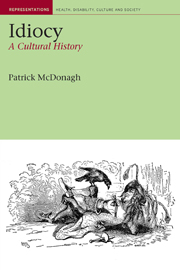Book contents
- Frontmatter
- Contents
- Preface and acknowledgements
- 1 Introduction: idiocy, culture and human relations
- 2 ‘Stripping our own hearts naked’: William Wordsworth and John Wilson read ‘The Idiot Boy’
- 3 A ‘pupil of innocent Nature!’ The wild boy of Aveyron goes to Paris
- 4 Diminished men: masculinity and idiocy
- 5 Essential women: femininity and idiocy
- 6 Holy fools, witty fools, depraved fools: folly, innocence and sin
- 7 History, society, economy: holy fools and idiots come home in nineteenth-century literature
- 8 Barnaby Rudge, idiocy and paternalism: assisting the ‘poor idiot’
- 9 Innocence, philanthropy and economics: the new ‘asylum’ idiot
- 10 Sensational idiocy
- 11 ‘The sins of the fathers’: idiocy, evolution and degeneration
- 12 Danger and degeneracy: the threat of the urban idiot
- 13 The problem of the feeble-minded: the Royal Commission, eugenics and eternal chaos
- Epilogue
- Bibliography
- Index
10 - Sensational idiocy
- Frontmatter
- Contents
- Preface and acknowledgements
- 1 Introduction: idiocy, culture and human relations
- 2 ‘Stripping our own hearts naked’: William Wordsworth and John Wilson read ‘The Idiot Boy’
- 3 A ‘pupil of innocent Nature!’ The wild boy of Aveyron goes to Paris
- 4 Diminished men: masculinity and idiocy
- 5 Essential women: femininity and idiocy
- 6 Holy fools, witty fools, depraved fools: folly, innocence and sin
- 7 History, society, economy: holy fools and idiots come home in nineteenth-century literature
- 8 Barnaby Rudge, idiocy and paternalism: assisting the ‘poor idiot’
- 9 Innocence, philanthropy and economics: the new ‘asylum’ idiot
- 10 Sensational idiocy
- 11 ‘The sins of the fathers’: idiocy, evolution and degeneration
- 12 Danger and degeneracy: the threat of the urban idiot
- 13 The problem of the feeble-minded: the Royal Commission, eugenics and eternal chaos
- Epilogue
- Bibliography
- Index
Summary
In May 1862, Margaret Oliphant's review article ‘Sensation Novels’ situated the popular new literary genre as an offspring of its era:
Ten years ago the world in general had come to a single crisis in its existence. The age was lost in self-admiration. We had done so many things that nobody could have expected a century before – we were on the way to do so many more, if common report was to be trusted.
(Oliphant 1862: 564)But all that had changed. ‘What a wonderful difference ten years makes!’, Oliphant writes. The ‘distant roar’ of war abroad – that is, the American Civil War – she explains
has come to form a thrilling accompaniment to the safe life we live at home and we … begin to feel the need of a supply of new shocks and wonders … it is only natural that art and literature should, in an age that has turned to be one of events, attempt a kindred depth of effect and shock of incident. (564–65)
Domestic fiction is no longer sufficiently exciting to hold the attention of readers, she suggests, and on this flat literary landscape Wilkie Collins's 1859 novel Woman in White emerges as a phenomenal success, effectively establishing a new genre: sensation fiction. Notably, this literary triumph comes by the novel employing ‘not so much as a single occult agency’, but rather producing its sensation ‘by common human acts’ (566) – that is, by acting on the human emotions to stimulate the senses, it renders the apparently mundane thrilling.
- Type
- Chapter
- Information
- IdiocyA Cultural History, pp. 231 - 256Publisher: Liverpool University PressPrint publication year: 2008



